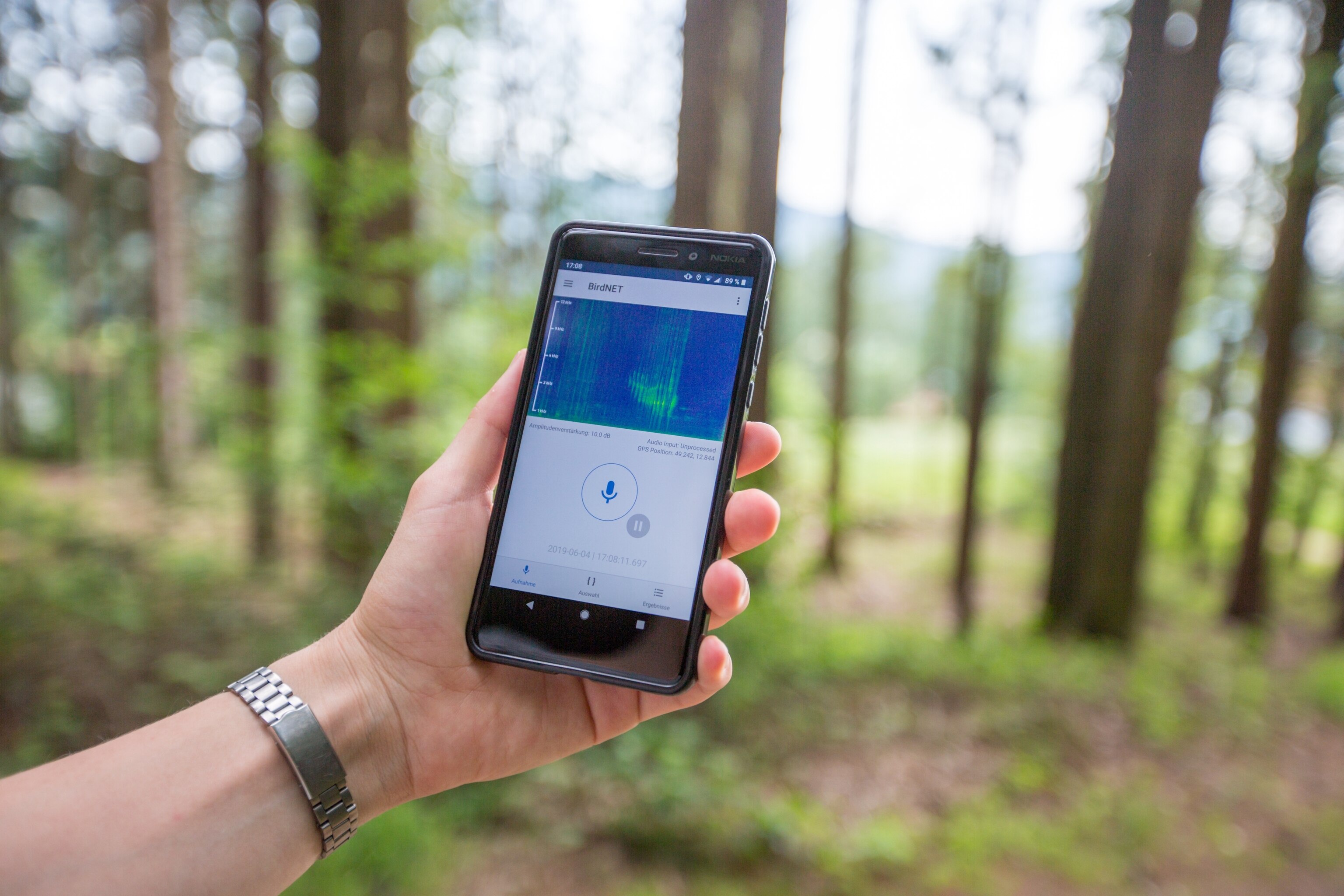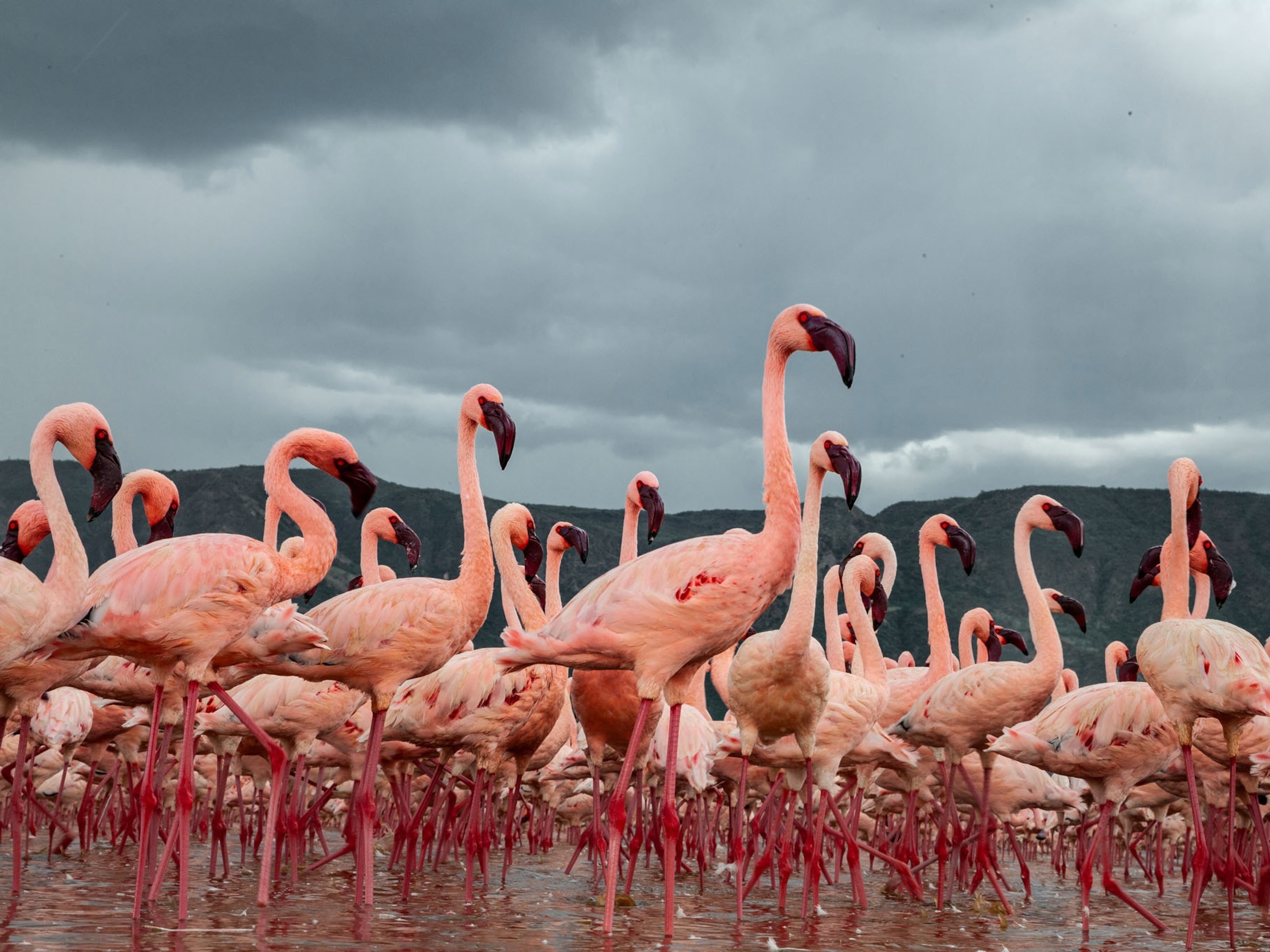How AI is helping scientists protect birds
As bird numbers fall worldwide, scientists and birders are using algorithm-powered apps to gather valuable data about avian species.

Each spring, scientists hide more than 1,600 lunchbox-size recorders across the lush forests of the Sierra Nevada range in the western U.S.
Until they’re retrieved at summer’s end, these devices record a million hours of audio, which often contains the hoots, barks, and whistles of the California spotted owl—valuable information about where the endangered species spends its time. But it’s a lot of recordings for a human to sift through.

"There's no way we can listen to that—not even close, right?" says Connor Wood, a research associate who co-leads the owl project at the K. Lisa Yang Center for Conservation Bioacoustics, part of the Cornell Lab of Ornithology in Ithaca, New York.
It turns out this team actually can process this deluge of data—they just need a little help from BirdNET, an AI-powered system launched in 2018 that can identify more than 6,000 species of birds across the globe just by their calls.
"We need tools that are really flexible and capable of identifying as many acoustically active animals as possible," says Wood, whose lab developed BirdNET with the Chemnitz University of Technology in Germany. "I really can't overstate how transformative [BirdNET] is for the field of bioacoustics."

Over the past decade, several apps have popped up that tap into the power of artificial intelligence to identify different avian sounds, which are used by scientists and birders alike. (Learn how the pandemic boosted citizen science.)
These tools have their faults: They can sometimes misidentify species, for instance. But more research is showing that AI can identify bird behaviors and distribution, which is critical for conservation.
How does it work?
In 2016, Cornell approached Stefan Kahl, a computer scientist at Chemnitz University of Technology, to help create an algorithm that processes bird sounds recorded in the wild.
Two years later, the team launched the official BirdNET app, which allows people across the world to upload their own recordings from a variety of devices, including laptops and smartphones. Since then, BirdNET has amassed roughly 150 million high-quality bird sounds.

Adding to this trove of data, Cornell's other AI-powered avian acoustic app, Merlin, has more than three million active users feeding acoustic data into the system. But how do these seemingly magical tools work?
The app converts a bird's song into an image of soundwaves known as a spectrogram. Then, the image is fed into the app's algorithm, which can pinpoint the unique frequency changes, timing, and amplitude of a particular call. (Learn how to get started as a birder.)
"These patterns that the algorithms find are much more subtle and fine-grained than what any human could do," says Kahl, who also works as a postdoctoral researcher at the Cornell Lab’s conservation bioacoustics center.

With funding from the U.S. Forest Service and National Park Service, Wood and his team recently used BirdNET to create the first ecosystem-wide assessment of spotted owl populations across the Sierra Nevada, which increasingly face threats from invasive species or wildfires. This information shows owl population trends that can boost restoration and conservation efforts, he says.
"Agencies are not just buying into this as a monitoring tool for telling them about populations, but to really specifically facilitate on-the-ground action, which is pretty exciting," Wood says.
Downsides to AI
However, like most AI-based technology, these apps are not without pitfalls.
In his 2023 study in the International Journal of Avian Science, ecologist Cristian Pérez-Granados reviewed a range of scientific literature on BirdNET. His research found that BirdNET didn't always register a bird's song, and sometimes misidentified it as another species, which results in "false positives," says Pérez-Granados, who works at the University of Alicante in Spain.
Merlin users have also reported cases of misidentification, which could have negative implications for research projects that incorporate citizen science data, according to the Audubon Society and other organizations.
"BirdNET and some other software have made a great difference in the last two or three years, but they need to continue growing and improving," Pérez-Granados says.

There are some ways to lessen these risks, including accounting for uncertainty using statistical models or manually going through identifications to double check data, which is the current process for Wood's spotted owl work.
"You need to treat it as a prediction" until you verify it, Wood says. "I'm glad to have some of these misclassification problems because at least it means we have bird-community data, which we never had before." (Related: Learn about 10 citizen science projects working to protect the environment.)
Indeed, a millions-strong brigade of citizen scientists are contributing copious amounts of data to apps like Merlin and BirdNET. For a 2022 study, Wood and his team assessed the accuracy of BirdNET submissions, and found their data could successfully replicate the known migratory routes of several North American and European birds.
A helping ear

Bird sound identification apps have made birding more accessible to many, particularly those with hearing loss.
About five years ago, Erin Rollins-Pletsch woke up one morning and discovered that she had lost roughly 80 percent of her hearing due to a rare disease. At first, she struggled to navigate the new—and much quieter—world around her. Then, she found her way to birding.
"When I am outside and focused on birds, none of the other things matter," says Rollins-Pletsch, a teacher who lives about 40 minutes east of San Francisco. (Read what happens to your brain when you see a bird in nature.)
However, she can't hear most of the high-frequency whistles, tweets, and chirps that help other birders track a species when it is out of sight. That’s why she now brings her smartphone outside and starts up the Merlin app.
"When I'm out gardening or tending to all my bird feeders in the backyard, I will just hit record on my phone," Rollins-Pletsch says.
"Then as the birds are singing, they just pop up on my phone one by one. [The app] reads out their singing to me. And I cannot even tell you how much I love it."
You May Also Like
Go Further
Animals
- How can we protect grizzlies from their biggest threat—trains?How can we protect grizzlies from their biggest threat—trains?
- This ‘saber-toothed’ salmon wasn’t quite what we thoughtThis ‘saber-toothed’ salmon wasn’t quite what we thought
- Why this rhino-zebra friendship makes perfect senseWhy this rhino-zebra friendship makes perfect sense
- When did bioluminescence evolve? It’s older than we thought.When did bioluminescence evolve? It’s older than we thought.
- Soy, skim … spider. Are any of these technically milk?Soy, skim … spider. Are any of these technically milk?
Environment
- Are the Great Lakes the key to solving America’s emissions conundrum?Are the Great Lakes the key to solving America’s emissions conundrum?
- The world’s historic sites face climate change. Can Petra lead the way?The world’s historic sites face climate change. Can Petra lead the way?
- This pristine piece of the Amazon shows nature’s resilienceThis pristine piece of the Amazon shows nature’s resilience
- Listen to 30 years of climate change transformed into haunting musicListen to 30 years of climate change transformed into haunting music
History & Culture
- Meet the original members of the tortured poets departmentMeet the original members of the tortured poets department
- Séances at the White House? Why these first ladies turned to the occultSéances at the White House? Why these first ladies turned to the occult
- Gambling is everywhere now. When is that a problem?Gambling is everywhere now. When is that a problem?
- Beauty is pain—at least it was in 17th-century SpainBeauty is pain—at least it was in 17th-century Spain
Science
- Here's how astronomers found one of the rarest phenomenons in spaceHere's how astronomers found one of the rarest phenomenons in space
- Not an extrovert or introvert? There’s a word for that.Not an extrovert or introvert? There’s a word for that.
- NASA has a plan to clean up space junk—but is going green enough?NASA has a plan to clean up space junk—but is going green enough?
- Soy, skim … spider. Are any of these technically milk?Soy, skim … spider. Are any of these technically milk?
Travel
- Dina Macki on Omani cuisine and Zanzibari flavoursDina Macki on Omani cuisine and Zanzibari flavours
- How to see Mexico's Baja California beyond the beachesHow to see Mexico's Baja California beyond the beaches
- Could Mexico's Chepe Express be the ultimate slow rail adventure?Could Mexico's Chepe Express be the ultimate slow rail adventure?







